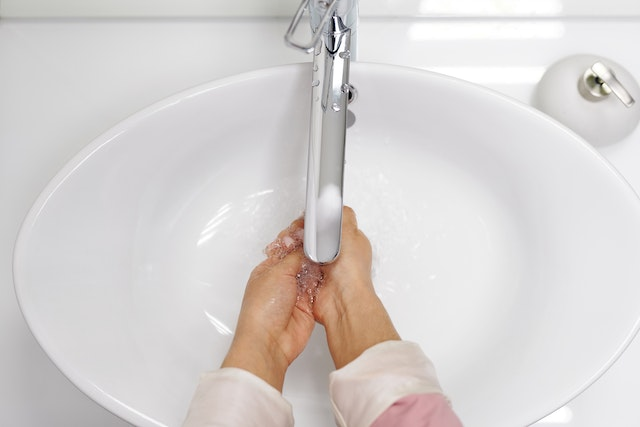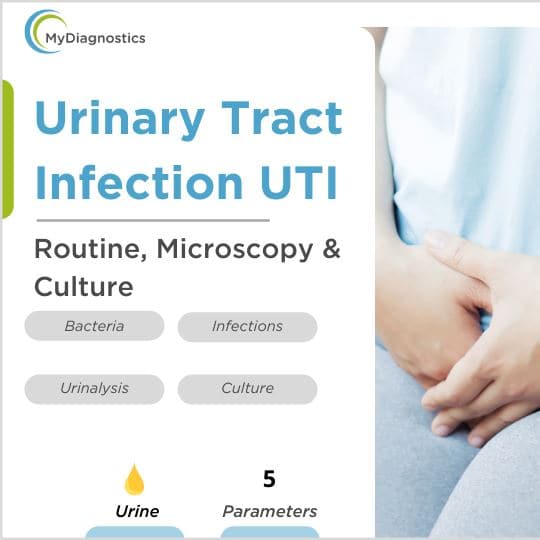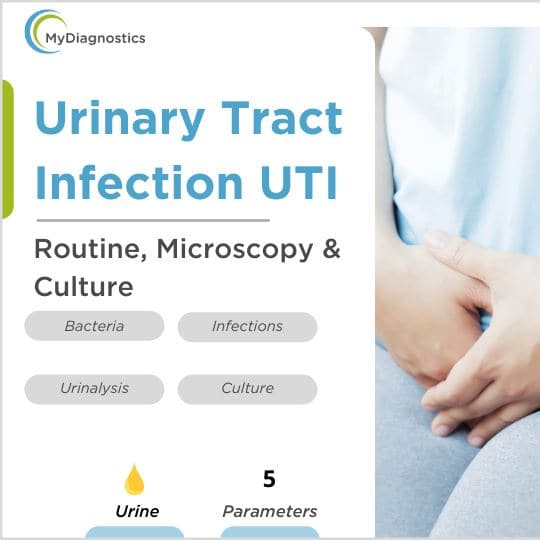UTI Test (Urinary Tract Infection) - Urine Culture Test at Best Price
Test Parameters

About the UTI Urine Culture Test at Home
The UTI test is a comprehensive urine test designed to check for urine routine and microscopy parameters. It also checks for urine culture development, which can provide information with regards to whether you may have a UTI. You can get your report generated within 12-48 hours with at-home sample convenience.
There are several different Urinary Tract Infection tests that may require more testing to diagnose a UTI, including:
- Urine routine test: A urine test is used to detect the presence of bacteria or white blood cells in the urine, which can indicate a UTI.
- Urine culture: A urine culture is a more detailed test that involves growing and identifying the specific type of bacteria that is causing the UTI.
- Urine microscopy: Urine microscopy involves examining a sample of urine under a microscope to look for abnormalities, such as the presence of bacteria or white blood cells.
Symptoms of Urinary Tract Infection (UTI)
A urinary tract infection (UTI) is an infection that occurs in the urinary tract, which includes the kidneys, ureters, bladder, and urethra. UTIs are more common in women than in men, but they can occur in anyone.
Some common symptoms of a UTI include:
Burning sensation during urination
A burning sensation or painful urination when you pee is one of the first signs of a UTI. A UTI screening test can be performed in the event that the burning sensation is turning into severe pain in the bladder.
Frequent urges to urinate
A frequent need to pee, multiple times throughout the day, could be an indicator of a UTI. You need to get a UTI lab test done if you suspect that you have a UTI.
Cloudy and foul-smelling urine
A cloudy appearing urine sample may contain some form of bacteria, indicating the presence of painful urination and a UTI. You should take a UTI home test as a diagnostic test for UTI, so that you can gain more clarity about why you are experiencing these symptoms.
Pelvic pain
Pain in the pelvic region can be an indicator of a UTI. You will need a urine infection test done, which is a urine test for UTI. You can order one at home, so that you can provide a sample conveniently with an at home Urinary Tract Infection test.

Blood in the urine
You may also see blood in the urine in the form of red spots, colour changes, and other indicators. If you find that there are signs of blood in your urine, then you should consult with your care provider about a UTI test result.
If you experience any of these symptoms, it is important to see a healthcare provider as soon as possible. To ensure the most effective treatment, UTIs can usually be treated with antibiotics, but if left untreated, they can lead to more serious complications.
It is important to drink plenty of fluids, as those who are at higher risk should void holding your urine for long periods of time, and practice good hygiene to help prevent UTIs. If you are prone to UTIs, your healthcare provider may recommend taking preventive measures, such as drinking cranberry juice or taking preventive antibiotics

What causes Urine Tract Infection
UTIs are most commonly caused by a bacterial infection when bacteria enter the urinary tract and multiply, especially in individuals with a weak immune system .
There are several factors that can increase the risk of developing a UTI, including
- Sexual activity: UTIs are more common in women who are sexually active, particularly if they use a diaphragm or spermicides for contraception.
- Structural abnormalities: UTIs are more common in people who have structural abnormalities in the urinary tract, such as a blockage or a malformation.
- Catheter use: UTIs are more common in people who use catheters (tubes that are inserted through the urethra to drain the bladder).
- Immune system problems: UTIs are more common in people who have compromised immune systems, such as those with HIV/AIDS or those who are receiving chemotherapy.
- Personal hygiene: UTIs are more common in people who do not practice good hygiene, such as those who do not wash their hands or genitals regularly.
- Holding urine for long periods of time: UTIs are more common in people who hold their urine for long periods of time, as this can allow bacteria to grow in the urinary tract.
- It is important to see a healthcare provider if you experience any symptoms of a UTI, as UTIs can usually be treated with antibiotics. If left untreated, UTIs can lead to more serious complications.

How to prevent UTI
Here are some tips to help prevent urinary tract infections (UTIs):
- Drink plenty of fluids: Drinking plenty of fluids, especially water, can help flush bacteria out of the urinary tract.
- Urinate when you feel the urge: Holding urine for long periods of time can allow bacteria to grow in the urinary tract.
- Wipe from front to back: Wiping from front to back after using the toilet can help prevent bacteria from the anus from entering the urinary tract.
- Practice good hygiene: Washing your hands and genitals regularly can help prevent the spread of bacteria.
- Wear loose-fitting clothing: Tight clothing can trap moisture and bacteria against the skin, which can increase the risk of UTIs.
- Avoid using perfumed products: Perfumed products, such as scented toilet paper and bubble bath, can irritate the urinary tract and increase the risk of UTIs.
- Avoid using diaphragms or spermicides: Diaphragms and spermicides can alter the balance of bacteria in the genital area and increase the risk of UTIs.

About the Quality
Quality assurance is done at 3 levels
- Sample collection from home using one time sealed QR coded sterile kits and transportation to the lab including the temperature condition requirements
- Sample acceptance and QC at the lab
- Sample run at the NABL/CAP/ISO certified labs





